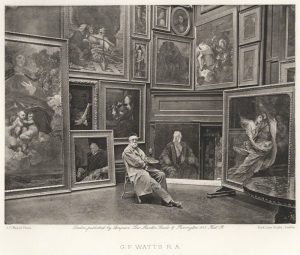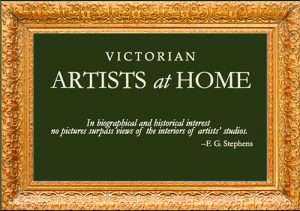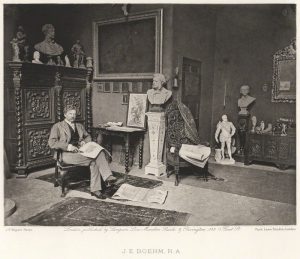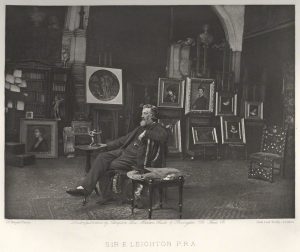A Domain of One’s Own: Teaching “Victorian Artists at Home”
As we head into summer, we thought it was appropriate to feature a teaching project that relates to the display of art in the domestic interior. Linda Merrill taught “Artists at Home: Celebrity Photographs and Popular Biography” at Emory University in Fall 2016, and the class created a “domain of one’s own” entitled “Victorian Artists at Home,” an exploration of the 1884 publication Artists at Home edited by the art critic F. G. Stephens and illustrated with photogravures by Joseph Parkin Mayall. As Merrill notes in her introduction to the text:
The particular novelty of Artists at Home, as the prospectus announced, lay in the detailed photographs of artistic interiors, replete with images of the “pictures, sculptures, and other objects of art which characterise those places.”[2] The viewer, then, would be treated not only to portraits of distinguished artists and glimpses into their private domains, but also to tiny replicas of actual works of art photographed with such precision that in many cases they could even be identified. The studio portrait of G. F. Watts, in which the artist is pictured in his private art gallery, would be lauded by the Publisher’s Circular for that very reproductive feat: “The photographer has had more than his usual success in bringing out the pictures which surround their famous author on the walls.”[3] To modern audiences this may not seem especially remarkable, but at the time, when the materials and techniques of photography were still evolving, the achievement was extraordinary. As the publisher explained in a note accompanying the plates, “the recent improvement in photography by the introduction of the Rapid Dry Plate has alone rendered the thing possible.”[4]
This post introduces readers to the site and its contents. The text below is excerpted from the site.
*Victorian Artists at Home explores Artists at Home (1884) by F. G. Stephens and J. P. Mayall, a collection of twenty-five plates and accompanying letterpress published in London by Sampson Low, Marston, Searle & Rivington, and in New York by D. Appleton & Co. The serial publication was issued over six months to some critical acclaim, and even today its images of prominent British painters, sculptors, and engravers ensconced in their own opulent studios give us insight into the social, aesthetic, and economic conditions that prevailed in the Victorian art world.
This exhibit is the collective project of Artists at Home: Celebrity Photographs and Popular Biography, an advanced undergraduate seminar in art history at Emory University. Designated a “Domain of One’s Own” project, the seminar took place in the fall of 2016. The nine undergraduates in the class spent the semester exploring primary evidence of celebrity culture in the Victorian period, focusing on a set of twenty-one photogravures—a partial collection of the twenty-five plates collected under the title Artists at Home (1884)—housed in the Stuart A. Rose Manuscript, Archives, and Rare Book Library at Emory University. The aim of the course was to comprehend and contextualize this rare portfolio of Victorian studio portraits and associated biographical sketches by exploring such topics as the place of the artist in the English Aesthetic movement; the purpose-built studio-house as a symbol of success and expression of artistic taste; the rise of “artistic” suburban neighborhoods in Victorian London; the production of similar projects in late nineteenth-century Paris and New York; the emerging practices of art-marketing in Victorian London; and, more generally, the cult of celebrity in the age of photography.
The students worked with primary sources and modern-day scholarly analyses to sharpen their visual and interpretive skills as they researched and catalogued each photogravure and its accompanying text. We used the Omeka platform and the Dublin Core classification system to compile an online archive, the source for the virtual exhibition contained on this site, Artists at Home. As the semester’s culminating project, each student created an exhibition of her own, allowing a more in-depth exploration of some related aspect of the project. Together, the website and constellation of exhibits are meant to elucidate the images and biographies that make up Artists at Home, and to position this extraordinary portfolio of prints in its original, richly textured cultural context. We are delighted to be able to make our findings available to a wide audience through the internet, and to provide not only a digitized version of the publication itself, but also illustrations of and links to works of art by the painters, sculptors, and engravers represented therein, many of whom enjoyed only this brief interlude of fame.
The plates and letterpress of Artists at Home on this site were reproduced from the holdings of the Stuart A. Rose Manuscript, Archives, and Rare Books Library at Emory University, Atlanta, GA, and the Department of Image Collections, National Gallery of Art, Washington, DC. Published in 1884, Artists at Home is in the public domain, and we invite users and researchers to use the images and texts provided here for private study, educational, and scholarly purposes. As far as we know, there are no known copyright restrictions on the images posted to our site, or to the physical materials displayed within the images. Reusing any image beyond a fair use as codified in section 107 of US Copyright Law or other applicable privilege is at your own risk: it is your sole responsibility to investigate the copyright status of an image and obtain permission when needed. We have made every effort to produce an openly accessible educational site that remains safely within the boundaries of fair use, and we trust that any inadvertent violations will be brought to our immediate attention.



